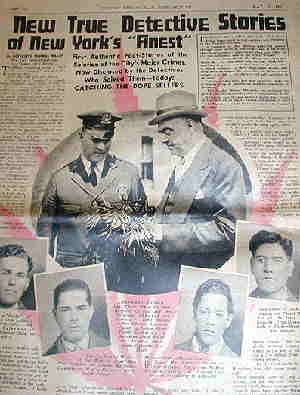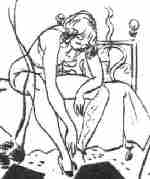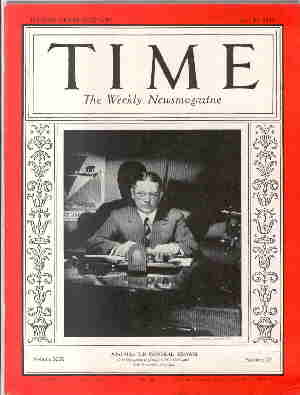
|
 |

|
|---|

Sunday-Mirror Magazine Section |
 THE REEFER MADNESS ERA |

TIME Magazine Cover |
|---|
The MAINSTREAM - NEWS MEDIA
(An Editorial Opinion)
There is a rumor (present without evidence here) that in the 1930's a major Editor/Publisher was approached by federal agents and told to either. "Print what we tell you to print, or we will make your sexual preference known to the public." If true, it would at least explain some of the inconsistencies associated with the reefer madness hysteria campaign. Especially as many of these same magazines had, just a decade earlier, carried glowing articles about Americans Hemp Crop and its wonderful future.
But for whatever reason the mainstream media seemed to follow a standard pattern that was also used by most local newspapers. A constant barrage of very short articles--- always mentioning Medical Marihuana in the negative. And then, every now and then, running a major article, one always featuring examples of bestial crimes said to have been committed, while under itís evil influence.
Perhaps the following listing for Time Magazine [1931-1950] provides us with a good example. Note that only three or four of them would qualify as reefer madness, the rest being only short (but negative) mentions.
TIME:
[ ]- Mar 2, 1931 Dope - Health & Medicine --Narcotic Education Week.
[ ]- Sept. 7, 1931 pp.18 - "Muggles" [Crime Section]
[ ]- June 13, 1932 "Black Rascal" [Arts * Entertainment section] Footnote read "Muggles smoking was the offense for which Louis Armstrong served a jail term last winter, Muggles : (also called reefers or Mary Warners, are shorter thinner than ordinary cigarets, cause a temporary, happy jag, cost 25 cents. The drug in Muggles comes from a variety of hemp called Marijuana."
[ ]- Sep. 26, 1932 New Plays in Manhattan - Arts & Entertainment
[ ]- Aug 28, 1933 pp 22] - Milestones - Died Frederick Starrr [NWR]
[ ]- July 23,m 1934 pp 9] - "The Cabinet" [National Affairs section] [NWR] Marihuana is only mentioned as part of something else.
[ ]- Aug 12, 1935 pp 42 - "Court Troubles" (about the Panama Cannel)
[ ]- Sep. 30, 1935 pp 51 - "N. R." - [Press section] - Panama Cannel area
[ ]- July 12, 1937 pp - Box-Car Bertha - (a kind of book review) about a women hobo [NWR]
[ ]- April 11, 1938 pp 32-[Medicine section] Description [picture of Dr. J.C. Munch]
[ ]- July 11, 1938 pp. 2 - LETTERS - New Deal Defined by Mary E. Hall, San Bernadino, Ca. [NWR]
[ ]- Sept 19, 1938 pp 65 "[Theatre section] Sent to the Cleaners" (circus sideshows that reportedly show the effects of Marihuana smoke) [NWR]
[ ]- Jan 23, 1939 pp23 - [Crime section] Five Mothers
[ ]- Feb 6, 1939 pp 2 - LETTERS - "Maudin Sympathy" [Obtain page 3]
[e]- "Jute, hemp and bedlam" - Mar 30 1942 -[N.W.R.]
[ ]- Dec 21, 1942 pp4 - [Letters] Lively black Dragon" [NWR]
[ ]- Jan 4, 1943 pp48 - [Miscellany section] "Hopped Hogs"
[ ]- Jan 11, 1943 pp21 - "The New Ursula Parrott Story"
[ ]- May 24, 1943 pp88 - "Airbaloney" [NWR] really not worth reading
[ ]- July 12, 1943 pp75 - "Down Beat"
[e]- "Weed" - July 19, 1943 - One of the more nervous heroes of hot jazz, Gene Krupa, went to California's San Quentin Prison this week to serve a sentence of one to six years. Drummer Krupa had been sentenced on two counts.4 Star Rating
[ ]- Aug. 02, 1943 Letters to the editor
[ ]- "Aug 16, 1943 pp4 - [Letters] "More About Marijuana" + "other letters + Ed.
[ ]- Aug 30, 1943 pp94 - [Miscellany section] "Canned Canaries"
[ ]- Nov 15, 1943 pp94 - [Cinema] "The New Pictures (Youth in Crisis)
[ ]- May 15, 1944 pp50 - [Miscellany] "Prize Crop" [N.W.R.]
[ ]- July 3, 1944 pp10 - [Miscellany] "Rough Reefer" [NWR]
[ ]- Oct 14, 1946 pp40 - [Latin America/Ecuador] "Reefer Ring"
[ ]- Mar 15, 1948 pp70 [Press section] Bane of the Bassinet (radio debate - Town hall) Comic books
[ ]- Jun 7, 1948 - Book review The Big Bonanza - Nation/NEW YORK
[ ]- June 28, 1948 pp2 - [Letters] "by Edward G. Bernard
[ ]- July 12, 1948 pp62 - [Press section] "Code for the Comics"
[S]- Sept 13, 1948 pp100 - [Cinema] "Crisis in Hollywood" - Article about the Robert Mitchum bust.
[ ]- Mar 13, 1950 pp108 --- [Miscellany] "Prescription"
[ ]- May 8, 1950 pp104 - [Miscellany] "The Straight Dope"
[ ]- Dec 4, 1950 pp40 - [Education] "Experiment in Infiltration" (very short mention)
[NWR] = Not Worth Reading
Ė August 14, 1937 -- SCIENCE (section)
MARIHUANA: New Federal Tax Hits Dealings in Potent Weed

Cannabis sativa, scraggly tramp of the vegetable world, grows with equal ease alongside Chinese railroad tracks, in Indianapolisí vacant lots, and on Buenos Aires ash dumps. Birdseed manufacturers harvest the mature plant thresh out the seeds, and use them to restore molting pigeons to health. The plantís fiber is twisted into rope and woven into cheap cloth.
It was neither of these legitimate uses that impelled Representative Robert L. Doughton of North Carolina to introduce a bill imposing a transaction tax on commerce in the weed; he was interested in Cannabis sativa because it is a dangerous and devastating narcotic -- known to the Orient as hashish, to the Occident as marihuana.
Through Turkish water pipes Indians and other Orientals for centuries have inhaled the acrid, tarry smoke of hashish. About a decade ago Negro musicians in New Orleans began drying and crushing the plantís leaves and rolling them into cigarettes. Known variously as bennys, reefers, mary Warners, and muggles, these cigarettes spread over the United States; shoestring peddlers market them for a dime apiece. Recently, Negro bandmen have introduced them to Londonís smart Mayfair.
Nearly every State has enacted legislation curbing production, and enforcement agents have discovered cultivated plots growing in Maryland, in Brooklyn, N.Y., and even in the San Quentin prison lot. But curbing the traffic without Federal aid has proved all but impossible. Since few policemen know enough botany to recognize the weed, arrests for cultivation and sale are made almost entirely by narcotics squads of big-city police forces. Doughtonís measure -- which became law last week when President Roosevelt signed it -- imposes a tax on all transactions; since no peddler would be foolish enough to pay such a tax, he is instantly liable to a $2,000 fine or a five-year jail term, or both.
Inhaling the smoke-- which is held in the lungs as long as possible -- impels some users to lassitude, others to violence. Generally, however, subjective reactions stick to one well-defined track:
Half an hour after smoking a reefer, the subject becomes jovial, carefree, and capable of rare feats of strength, Hallucinations follow; space expands and time slows down; a minute seems like a day and a room looks like a place viewed from the large end of a pair of binoculars. This phase is valuable to hot-band players -- time distortion slows down everything and gives opportunity to crowd in a dozen cornet notes where previously there was only time for one. The third stage of intoxication is the dangerous one. The weed acts as a powerful aphrodisiac and renders users capable of various acts of violence; a California man decapitated his best friend while under the violent spell of the smoke, and a Florida youngster put the ax to his mother and father.
No one can guess how widespread use of the narcotic is. Sensational press stories about its use in grade and high schools generally prove unfounded. New York, the nationís biggest consumer, jailed 42 users and sellers last year and has collared 37 so far this year. Main concern of narcotics squads, however, are the marihuana rings, wholesalers to agents.

|
MUSEUM COMMENTS (Selected Genres) |

|
|---|
WANT TO KNOW MORE:
=====================
Due to space / download time considerations, only selected materials are displayed. If you would like to obtain more information, feel free to contact the museum. All our material is available (at cost) on CD-Rom format.
CONTACT PAGE
|
BACK TO THE MAIN WEBSITE HOME PAGE  THE REEFER MADNESS ERA |
HOME PAGE MAGAZINE |
MAGAZINE COMMENTS (SELECTED GENRES) |
||||
|---|---|---|---|---|---|---|
|
MAGAZINE MAIN INDEX |
1
|
2
|
3
|
4
|
5
|
|
|
SEARCHING INDEX |
6
|
7
|
8
|
9
|
10
|
|